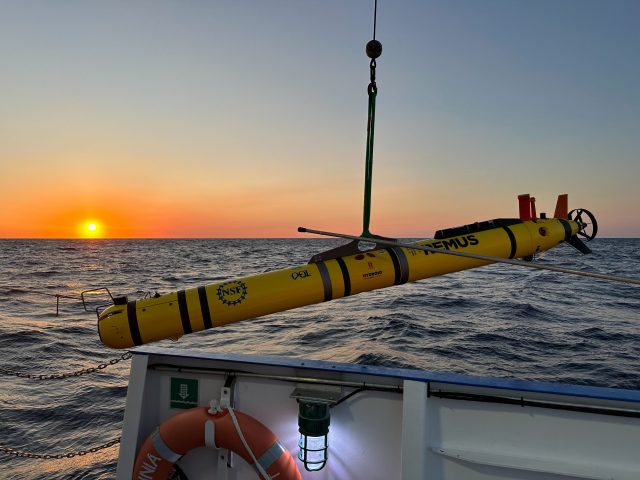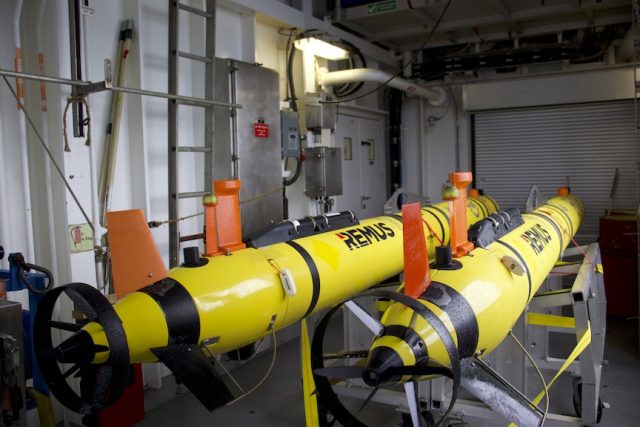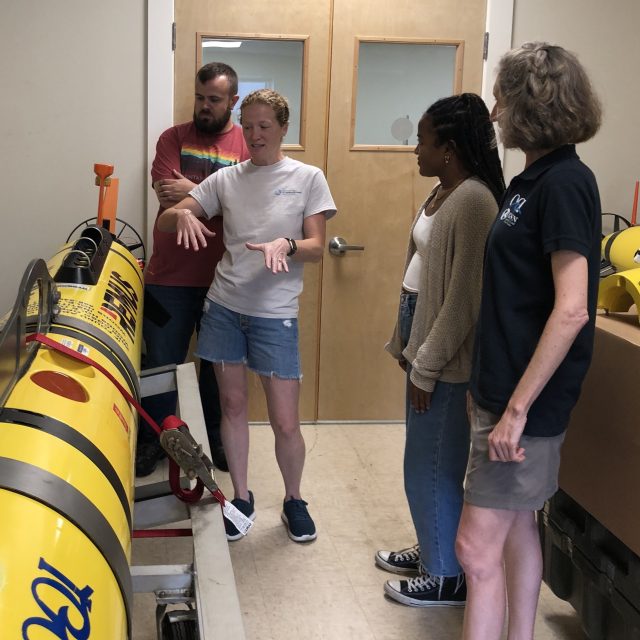Posts Tagged ‘Autonomous Underwater Vehicles’
OOI-CGSN Team Completes First Standalone AUV Cruise at Pioneer MAB Array
The Ocean Observatories Initiative’s (OOI) Coastal and Global Scale Nodes (CGSN) team recently conducted their first standalone small vessel Autonomous Underwater Vehicle (AUV) cruise at the Pioneer Mid-Atlantic Bight (MAB) Array. Aboard the R/V Virginia, team members Andy Robinson, Collin Dobson, and Dan Bogorff successfully completed dock testing of their launch and recovery systems before heading offshore to carry out AUV transects through the array.
The mission utilized two REMUS600 AUVs, equipped with a variety of scientific instruments, including CTDs (conductivity, temperature, depth), fluorometers, dissolved oxygen sensors, nitrate sensors, photosynthetically active radiation (PAR) sensors, and ADCPs (acoustic doppler current profilers). These tools provide essential data for understanding ocean conditions and biogeochemical processes at the Pioneer MAB array.
This accomplishment highlights the OOI-CGSN team’s dedication to advancing autonomous AUV ocean exploration and data-driven research.
[gallery size="full" ids="34951,34952,34953,34954,34955,34956"](c): Collin Dobson
Read MoreA Remarkable Underwater Robot
Two REMUS 600 autonomous underwater vehicles (AUVs) are components of the Coastal Pioneer Array at its new location in the Mid-Atlantic Bight (MAB). Their mission is to collect data through the water column and in between moorings, serving as an additional data source and validating data collected at the stationary moorings.
The two AUVs at the Mid-Atlantic site will be collecting data at the site 4-6 times/year. They will travel across the shelf and along the shelf on a prescribed route within the footprint of the moored array.
[media-caption path="https://oceanobservatories.org/wp-content/uploads/2024/04/MAB_VIP_AUV.jpg" link="#"]The AUV sampling route at the Coastal Pioneer Array in the MId-Atlantic Bight.[/media-caption]Prior to being loaded onto the R/V Neil Armstrong for the initial deployment at the MAB site, the OOI Coastal and Global Scale Nodes (CGSN) vehicle team at Woods Hole Oceanographic Institution (WHOI) put them through a rigorous series of checks to make certain they will operate without incident in this new location.
“We run the vehicle through a whole bunch of lab and bench tests, so we are confident that all major systems are working, and it is capable of executing a pre-programmed route when in the water,” explained CGSN Vehicle Lead Diana Wickman.
Once the AUVs passed inspection, they were loaded on the R/V Neil Armstrong to make their way to the MAB. The onboard vehicle team of Wickman and Andy Robinson still had tasks to accomplish before setting them on their journey.
The team mapped a detailed route with waypoints related to the configuration of the Pioneer Array in this new location. These AUVs will survey the array at three knots (as opposed to gliders, which travel at 0.3 knots). This faster AUV speed through the water makes it possible to capture dynamic flows and currents, which is especially important in the more complex area of the MAB. Once programmed, the vehicle team maintains control of the AUV from the ship via a Vehicle Interface Program (VIP)—a specialized program designed to communicate with the deployed AUV. The VIP gives the AUV team the ability to monitor health and performance of the vehicle and change parameters or alter the mission, when and if needed.
An ability to track the AUVs while they are underway is especially important for the way they are used at the Pioneer Array. “Our vehicles’ configuration makes it possible to cover more ground and complete longer surveys than more traditional AUVs could achieve,” said Robinson, CGSN Vehicle Technician. They were designed with efficiency in mind, carrying a streamlined sensor payload rather than the power-hungry sonar or mapping equipment that many REMUS AUVs operate. This allows the vehicles to stay deployed for at least 24 hours, each set to cover 110 km (68 mi) in a typical mission at the MAB.
[media-caption path="https://oceanobservatories.org/wp-content/uploads/2024/04/IMG_1378-copy.jpg" link="#"]These two AUVs will “fly” through water at the new location of the Coastal Pioneer Array in the MId-Atlantic Bight on April 6, 2024. Credit:DT Crist © WHOI.[/media-caption]AUVs are equipped with the same sensors as the four gliders that will be deployed in this new array location. The AUVs will supplement and validate the data being collected by the gliders as well as the moorings. In contrast to the AUVs’ intermittent surveys, gliders will stay onsite and capture data for the six months the array will be in the water. The AUVs’ data collection trips serve to validate the data collected by the gliders as well as providing additional data to promote understanding of conditions in the region.
The AUVs will make their first reports from the MAB this Saturday, April 6, 2024.
Read More
AUV Data Available in a Variety of Formats
We recently announced and demonstrated new access to autonomous underwater vehicle (AUV) data through OOI’s Data Explorer. Since the initial announcement, more has been done to provide additional AUV data and improve data delivery. As part of OOI’s efforts towards Findable, Accessible, Interoperable, and Reusable (FAIR) data, not only are AUV data easier to find and access, we now are providing these data in more interoperable and reusable formats.
When you view an AUV Deployment in Data Explorer (FIG 1), data in different formats may be accessed either through the Metadata link in the left panel (FIG 1 A) or the Downloads button (FIG 1 B). The Downloads button provides access to data products, in formats including comma separated variable (CSV), that are derived from Network Common Data Form (NetCDF) files in the OOI Raw Data Repository. To access these NetCDF files, open the Metadata link, navigate into that deployment’s folder, and then into its PROFILES subfolder. Note that each deployment’s folder also contains raw data as collected by the vehicle and an EXPORTED subfolder for data products in Matlab format.
[media-caption path="https://oceanobservatories.org/wp-content/uploads/2024/01/AUV_OOI_newsletter_Fig1_portrait.png" link="#"]Fig. 1 AUV Deployment in Data Explorer. Inset A: Metadata link to Raw Data Repository to access NetCDF format per deployment in PROFILES subfolder. Inset B: Downloads button provides data products in multiple formats. Credits: Screen grab from Data Explorer (https://dataexplorer.oceanobservatories.org/#platform/c646022c-ce04-5be8-8cd8-117da55121fa/v2?pid=14&tab=visualization) and Flaticon. Flaticon license: Free for personal and commercial use with attribution.[/media-caption]The software development effort by OOI’s Coastal & Global Scale Nodes (CGSN) Team to publish AUV data into Data Explorer involved OOI’s Cyberinfrastructure Team and Axiom Data Science. This effort builds on earlier work by OOI’s Coastal Endurance Array Team to publish glider data into the IOOS Glider DAC, and subsequently into OOI’s Data Explorer. The existing code base was integrated into a larger framework supporting the input of either glider or AUV data and supporting output formatting compatible with either or both the Glider DAC or Data Explorer.
CGSN maintains two AUV platforms, which are deployed from shipboard as part of at-sea operations in and around OOI mooring sites. The AUVs conduct ~24 hour transects, consisting of multiple profiles of the water column, before being retrieved by the ship for data collection and maintenance. CGSN AUV platforms are fitted out with a variety of instrumentation including CTD, fluorometer, and sensors for photosynthetically active radiation, dissolved oxygen, dissolved nitrate, and current measurement. When applicable, annotations are provided per deployment per instrument in OOI’s OOINet portal and M2M (Machine to Machine) interface; we plan to incorporate these annotations into NetCDF metadata and ultimately into Data Explorer.
[media-caption path="https://oceanobservatories.org/wp-content/uploads/2024/01/IMG_126519-2.jpg" link="#"]CGSN Team member Diana Wickman (2nd from left) explains how the AUV moves during a deployment, with CGSN Team members Collin Dobson (far left) and Stace Beaulieu (far right) and student researcher Taina Sanchez (2nd from right). Credit: D. Trew Crist © WHOI.[/media-caption]
The Data Explorer provides access to all across-shelf and along-shelf AUV deployments at the Coastal Pioneer NES Array from 2016 to 2022.Future AUV transect data at the Coastal Pioneer MAB Array will also be published through Data Explorer as the data become available. As an example for reusability of these data in newly-available formats, a student examined across-shelf patterns in salinity, chlorophyll, and nitrate as part of Northeast U.S. Shelf Long-Term Ecological Research.
Read More



